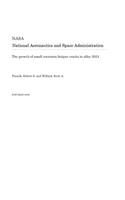
The Growth of Small Corrosion Fatigue Cracks in Alloy 2024
Series:
The corrosion fatigue crack growth characteristics of small surface and corner cracks in aluminum alloy 2024 is established. The damaging effect of salt water on the early stages of small crack growth is characterized by crack initiation at constituent particle pits, intergranular microcracking for a less than 100 micrometers, and transgranular small crack growth for a micrometer. In aqueous 1 per
2024
VOLUME
English
Paperback

The corrosion fatigue crack growth characteristics of small surface and corner cracks in aluminum alloy 2024 is established. The damaging effect of salt water on the early stages of small crack growth is characterized by crack initiation at constituent particle pits, intergranular microcracking for a less than 100 micrometers, and transgranular small crack growth for a micrometer. In aqueous 1 percent NaCl and at a constant anodic potential of -700 mV(sub SCE), small cracks exhibit a factor of three increase in fatigue crack growth rates compared to laboratory air. Small cracks exhibit accelerated corrosion fatigue crack growth rates at low levels of delta-K (less than 1 MPa square root of m) below long crack delta-K (sub th). When exposed to Paris regime levels of crack tip stress intensity, small corrosion fatigue cracks exhibit growth rates similar to that observed for long cracks. Results suggest that crack closure effects influence the corrosion fatigue crack growth rates of small cracks (a less than or equal to 100 micrometers). This is evidenced by similar small and long crack growth behavior at various levels of R. Contrary to the corrosion fatigue characteristics of small cracks in high strength steels, no pronounced chemical crack length effect is observed for Al by 2024 exposed to salt water. Piascik, Robert S. and Willard, Scott A. Langley Research Center RTOP 538-02-10-01...
Price Comparison [India]
In This Series
Bestseller Manga
Trending NEWS




















